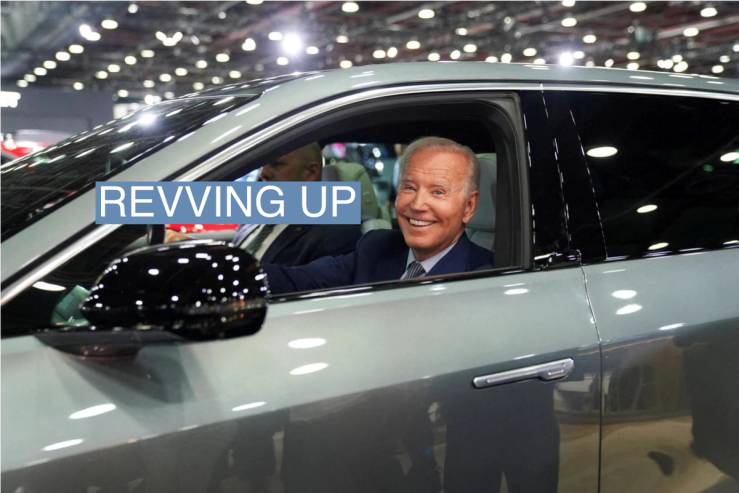The News
Washington’s budget wonks may have underestimated the size of Joe Biden’s signature climate legislation, the Inflation Reduction Act, when it passed last year — and by a lot.
At the time, Capitol Hill’s official scorekeepers predicted that the bill’s tax credits for clean energy and green manufacturing would cost about $270 billion over a decade — making it the country’s largest ever investment in decarbonization.
But last week, as House Republicans sought to repeal much of the law in their debt ceiling bill, the nonpartisan Joint Committee on Taxation revised the price tag. The new forecast: $468 billion through 2031, the last year covered by both the new and original estimates.
Even that total was dwarfed, however, by a Goldman Sachs prediction in March that the IRA would end up costing the government $1.2 trillion dollars while spurring another $1.5 trillion in private green investments.
Jordan’s view
Conservatives have already seized on the new estimates to bash Democrats — and the bill’s key architect, Sen. Joe Manchin, in particular — who pitched their legislation as a deficit reduction package. In response to Goldman’s eye-popping figure, for instance, the Wall Street Journal’s editorial page groused that the party had “created an enormous new corporate entitlement whose costs will increase on autopilot and blow up the deficit.”
But while the politics may be a little tricky for Biden or Manchin, the bigger forecasts should be greeted as fantastic news by climate hawks, since they mostly seem to reflect early signs that the bill is working as intended. More public spending that encourages more private spending on decarbonizing the economy is the virtuous cycle they always wanted.
Start with the joint committee’s latest figures: Most of the additional spending — or about $105 billion — is expected to flow toward subsidies for green manufacturing, meant to ensure that key parts of the renewable supply chain, from critical minerals to batteries to solar panels and wind turbine components, are built in the United States. More spending on tax credits for renewable energy, another top climate goal, explains another $72 billion of the increase.
The Joint Committee doesn’t explain the reasoning behind their revisions. But it appears to reflect the way companies have sprinted to announce new energy projects and factories to take advantage of the tax credits — especially in the auto industry, where firms have been positioning themselves for an electric vehicle boom.
The advocacy group Climate Power counts 40 new battery manufacturing projects that have been announced between the IRA’s passage and the end of January, and finds that 22 companies have announced new electric vehicle manufacturing plans. The numbers have surprised some expert forecasters, who thought the auto industry would be less eager to make large-scale domestic investments in order to qualify for consumer tax credits on individual car models.
“We didn’t think there would be this much quick demand on the battery manufacturing tax credit,” Anand Gopal, head of policy research at Energy Innovation, which has produced widely cited projections of the IRA’s impact. “We’re talking about the possibility of a real battery belt in the Southeast. That’s freakin’ amazing.”
The View From The Treasury
Deputy Treasury Secretary Wally Adeyemo told me that the rush of new factory announcements showed that the IRA was already “having a bigger impact than anyone ever expected it to.” However, he argued that it was still uncertain how much the legislation would ultimately cost, in part because other countries are now trying to compete with the U.S. by passing their own subsidies for renewable and EV manufacturing. That could draw factories away from the U.S., he said, and lead Washington to spend less on tax credits.
The View From Climate Experts
When Congress passed the IRA last year, various outside analysts suggested that it would help push U.S. greenhouse gas emissions 32% to 40% below 2005 levels. The new cost numbers aren’t likely to affect those guesses, because climate modelers used their own, independent estimates of how industry would respond to the bill’s incentives.
Instead, what seems to be happening is that Capitol Hill’s budgeteers are changing their forecasts to look more like what those climate experts already thought the bill would do.
John Larsen, head of energy policy at the Rhodium Group, told me that the Joint Committee on Taxation and Congressional Budget Office have a long history of underestimating the cost of renewable energy subsidies because they tend to make conservative guesses about how quickly new technologies will be rolled out. “That’s just them. I’m not saying it’s a good thing or bad thing. It’s just their track record,” he said.
In this case, that dynamic may have worked in Democrats’ favor, by helping them keep the on-paper cost of their bill down during negotiations.
Know More
While the Joint Committee’s new numbers seem to reflect an emerging conventional wisdom about how companies are embracing the IRA, budget and climate experts I spoke with were generally more skeptical about Goldman’s mammoth forecast, which makes some heroic assumptions about how fast certain technologies will roll out.
Take EVs. The bank’s analysts predict that by 2030, hybrid and electric vehicles will make up 70% of new car and truck sales, higher than any other estimate from a major analyst. The Biden administration is only aiming for 50% by that year.
The bank also predicts that the majority of those vehicles will meet the stringent domestic manufacturing requirements necessary to qualify for the IRA’s tax credits, even though only 14 models currently make the cut. As a result, it thinks the government will spend almost $393 billion subsidizing electric vehicles, compared to $14 billion originally predicted by the Joint Committee.
If Goldman’s predictions were to pan out, it would mean the U.S. economy was decarbonizing at a pace even some of the most optimistic experts don’t expect as of now.
Room for Disagreement
The prospect of a faster transition to electric vehicles isn’t thrilling Manchin. He’s been feuding with the Biden administration over its implementation of the Inflation Reduction Act — even threatening to vote to repeal his own bill — and is particularly upset about how it has approached the EV subsidies. He argues the White House isn’t being strict enough about how much of a car’s key components, such as the minerals in batteries, need to be produced in the U.S. to qualify, which could leave supply chains dangerously dependent on China in the long term.
“American tax dollars should not be used to support manufacturing jobs overseas,” Manchin said in March, after the administration rolled out its new tax credit rules. “It is a pathetic excuse to spend more taxpayer dollars as quickly as possible and further cedes control to the Chinese Communist Party in the process.”
Notable
- Goldman Sachs’ analysts aren’t the only ones who think the IRA’s could be much, much more expensive than even the Joint Committee’s revised estimates suggest. An economics paper presented at Brookings in March suggested the tax credits could cost $780 billion by 2031, and grow to $1.2 trillion by 2040. “What you’re seeing is a large amount of uncertainty in how much clean energy is actually going to be deployed,” one of the paper’s authors told the New York Times.


